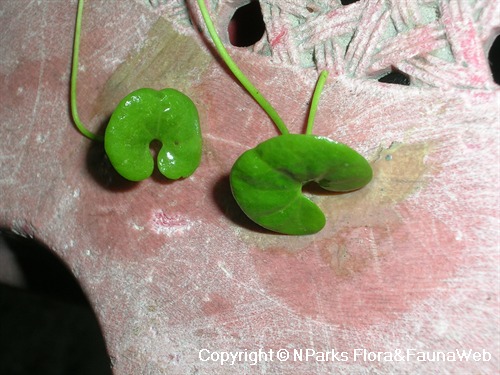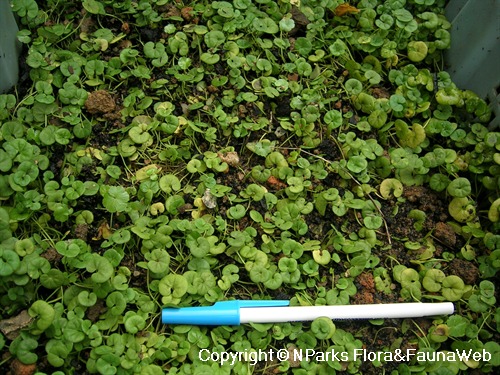
Back
Dichondra repens
| Family Name: | Convolvulaceae |
| Common Name: | Kidney Weed, Kidney Grass, Dewdrop Lawn, Wonder Lawn, Mercury Bay Weed |
Name
Classifications and Characteristics
| Plant Division | Angiosperms (Flowering Seed Plants) (Dicotyledon) |
|---|---|
| Plant Growth Form | Shrub |
| Mode of Nutrition | Autotrophic |
Biogeography
| Native Distribution | Australia, New Zealand |
|---|
Description and Ethnobotany
| Growth Form | It is a fast - growing groundcover. It creeps and forms a thick mat. |
|---|---|
| Roots | Roots grow at the nodes. |
| Foliage | Leaves are green, small and reniform (kidney-shaped), measuring about 5 - 25 mm in diameter, apex is rounded to emarginate, base is cordate, the petioles are much longer than lamina. |
| Flowers | Flowers are solitary, each pedicel measures 10 - 50 mm long. Its calyx (sepal) lobes are obong-elliptic, measuring 2.5 - 4 mm long. Corolla is pale green to yellow, shorter than calyx, short tube. |
| Fruit | Capsule, covered with soft hair. |
| Habitat | Grows abundantly in forests, woodlands, grasslands, and lawns as well as sandy soils. |
| Similar | It is similar to Centella cordifolia but Centella can be distinguished by its slightly scalloped leaf edge while Dichondra is smooth edged. For Dichondra, the part where the stem joins to the leaf, the gap is much more rounded. |
| Cultivation | Cultivated mostly for groundcover purposes. |
| Etymology | The genus Dichondra means two-lumped, which refers to the two-lobed ovary. The specific epithet repens means creeping, which refers to its growth habit. |
| Ethnobotanical Uses | Food (Herb or Spice) Medicinal: It is a main ingredient in herbal beverages in Taiwan for its antioxidant and anti-inflammatory effects. It was believed to have been consumed as a nutrition supplement for liver. |
Landscaping Features
| Desirable Plant Features | Ornamental Foliage |
|---|---|
| Landscape Uses | Small Gardens, Groundcover, Suitable for Hanging Baskets |
Plant Care and Propagation
| Light Preference | Semi-Shade, Full Sun |
|---|---|
| Water Preference | Moderate Water |
| Rootzone Tolerance | Moist Soils |
| Propagation Method | Division |
Foliar
| Foliage Retention | Evergreen |
|---|---|
| Mature Foliage Colour(s) | Green |
| Foliar Type | Simple / Unifoliate |
| Foliar Attachment to Stem | Petiolate |
| Foliar Shape(s) | Non-Palm Foliage (Reniform) |
| Foliar Margin | Entire |
| Foliar Apex - Tip | Emarginate, Rounded |
| Foliar Base | Cordate |
| Leaf Area Index (LAI) for Green Plot Ratio | 4.5 (Shrub & Groundcover - Dicot) |
Floral (Angiosperm)
| Flower Colour(s) | Green, Yellow / Golden |
|---|---|
| Flower Grouping | Solitary |
| Individual Flower Shape | Tubular |
| Flowering Period | Free-Flowering |
Image Repository
Others
| Master ID | 636 |
|---|---|
| Species ID | 1931 |
| Flora Disclaimer | The information in this website has been compiled from reliable sources, such as reference works on medicinal plants. It is not a substitute for medical advice or treatment and NParks does not purport to provide any medical advice. Readers should always consult his/her physician before using or consuming a plant for medicinal purposes. |

